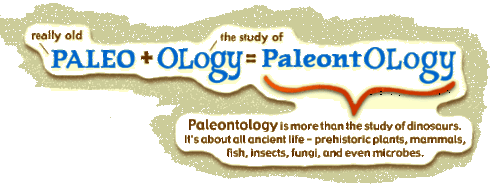


Before you dive into The BIG Dig, here's the scoop on fossils.
Fossils tell stories about Earth's history.
Paleontology is packed with mysteries about living things such as plants and animals that lived thousands, millions, and billions of years before the first modern humans. To solve these mysteries, paleontologists use fossils.
Fossils are the remains or traces of ancient life that are usually buried in rocks. Examples include bones, teeth, shells, leaf impressions, nests, and footprints. This evidence reveals what our planet was like long ago. Fossils also show how animals changed over time and how they are related to one another.
Fossils can't tell us everything.
While fossils reveal what ancient living things looked like, they keep us guessing about their color, sounds, and most of their behavior.
Fossils are very rare.
Most ancient living things never became fossils. When they died, scavengers ate them, they decayed, or they were worn away by wind and water until they disappeared. Some were destroyed by Earth's heat and pressure. Luckily for us, some living things were preserved as fossils.
The Fossil record is like a big jigsaw puzzle, with most of the pieces missing.
Most of the fossils of living things will never be found. They may be buried too deep, or they may be in the parts of the world where no one is digging. Many species probably left no fossils at all. Still, plenty of fossils have been found, and new ones are being discovered all the time. Each year, paleontologists continue to piece together the stories of the past.




 Biodiversity
Biodiversity
 Brain
Brain
 Genetics
Genetics
 Marine BiOLogy
Marine BiOLogy
 MicrobiOLogy
MicrobiOLogy
 PaleontOLogy
PaleontOLogy
 ZoOLogy
ZoOLogy
 AnthropOLogy
AnthropOLogy
 ArchaeOLogy
ArchaeOLogy
 Astronomy
Astronomy
 Climate Change
Climate Change
 Earth
Earth
 Physics
Physics
 Water
Water
